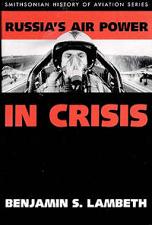
Russia's Air Power in Crisis
Benjamin S. Lambeth
233 pages including index
published in 1999
The end of the Cold War was strange, because it wasn't the nuclear holocaust we all imagined it was going to be, the final confrontation between the free west and the communist east. Instead it ended with a whimper, not a bang, as the Soviet empire collapses from the inside. With it crumbled the Russian army, which went from being an unstoppable menace to a laughing stock in the space of less than a year. Budgets were slashed, careful gathered stockpiles of weapons were destroyed or sold, units were brought back from Eastern Europe and when the USSR itself split, suddenly not just hte army was split over a dozen different countries, but also its supporting infrastructure of weapon plants, repair depots and design bureaus...
The various new Russian army branches therefore had to meet formidable challenges in the post-Soviet era, perhaps none more so than its airforces. It's this that's the subject of Russia's Air Power in Crisis, which looks at these problems through a somewhat American lens. This is most visible in the constant references the author makes to the role American airpower played during the First Gulf War and the impression this made on the Russians. More subtly, it's also visible in the assumption of how airpower should be used, in that a proper airforce should be like the USAF and adhere to its philosophy. It speaks for Lambeth that he recognises this tendency in himself, when he discusses what might have been the outcome if the balloon had gone up and the Soviet and NATO airforces had met each other in the skies above Western Europe.
He recognises that the Soviets always saw the airforce as strictly utilitarian, a sort of flying artiller wholly subordinate to serving the groundforces in meeting their objectives, while the US Airforce has always been much more independent, more intend on first winning air superiority and only then getting involved in the landbattle, more bound to the idea that airpower in itself can win wars. This difference in philosphy also led to a difference in approach: where the American fighter pilot was left to do the job he was assigned, Soviet pikots were always guided to their targets from the ground, with little room for their own initiative. This has always been seen as the great disadvantage of the Soviet system and simultaneously Soviet pilots were largely thought to be inferior to their western counterparts, but if this approach means that the objectives are met even if ninety percent of the airforce is lost, it may have been the right choice considering the strategical context. However this approach, which the Russian airforce, the VVS, inherited and which shapes their entire training and tactical doctrine, now severily hinders it in carrying out its new duties in a much more uncertain world.
Lambeth therefore spents a large part Russia's Air Power in Crisis looking at how the VVS now handles it training and its everyday duties and how it deals with changing its doctrine in an environment where few if any units ever have enough fuel or even enough planes to meet even the minimum standard of flight experience maintainance for all its pilots. After having spent several chapters exploring this, Lambeth also looks at the only test the new Russian airforce had at the time when this book was published to put its training to the test: the First War in Chechnya. What I found interesting here are the problems Lambeth identifies that the VVS had to deal with. It had to operate in an often urban environment in which the enemy is intermingled with civilians. It had air superiority but there was still the risk of short range low level anti-aircraft fire and shoulder fired missiles, which forced the airplanes to operate from higher altitutes, trading accuracy for safety. Meanwhile clear military targets of the kind it could expect in a war against NATO were scarce so many of the problems facing the Russians in Chechnya could not be solved by airpower. These are exactly the problems the US Airforce also has to deal with in Iraq and Afghanistan. On the whole Lambeth judges the Russians did a credible job with limited resources, but the airwar in Chechnya did show the limitations of the Russian airforce.
Apart from the organisation itself and the problems and legacies it inherited from the Soviet era, Lambeth also looks at the future of the VVS. It has had huge difficulties keeping its airplanes flying, nevermind getting new planes, let alone getting new types of planes in service. The production lines for even the most advanced planes have barely been kept open, mainly through export orders, development of more advanced versions of the Mig-29 or Su-27 for example has been very slow and finding a replacement for these types had almost completely stalled. At the same time there still is the organisational problem to be dealt with, as the Soviet legacy of a separate airdefence service, the VPVO, next to the airforce had not yet been dealt with, and the airforce still needed to scale down to live within its budgets. Since the time this book has been written, much has changed of course, but these problems have not yet been completely solved, nor are they likely to be anytime soon. These will take years, if not decades to solve.
Read more about:
Benjamin S. Lambeth,
Russia's Air Power in Crisis,
Russia,
air warfare,
book review